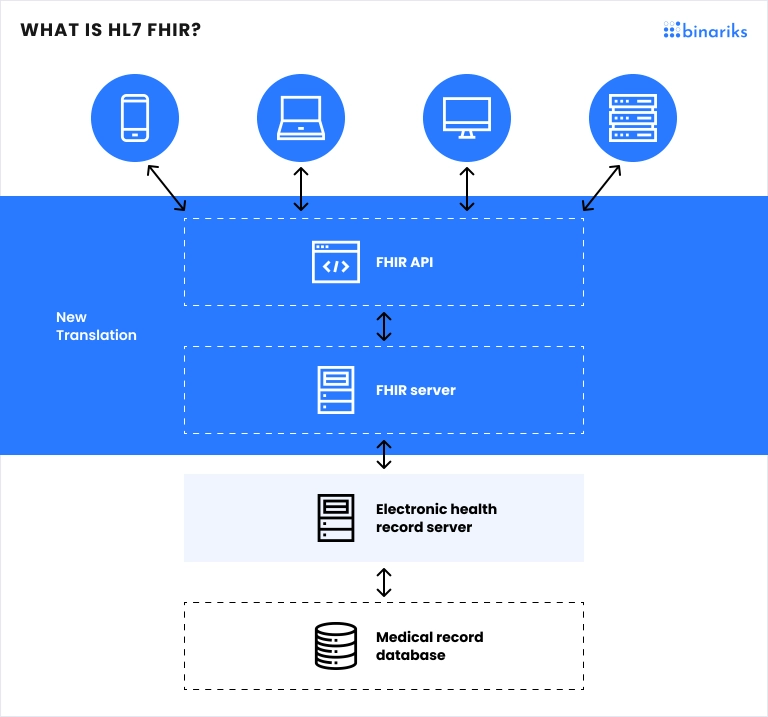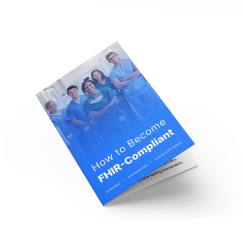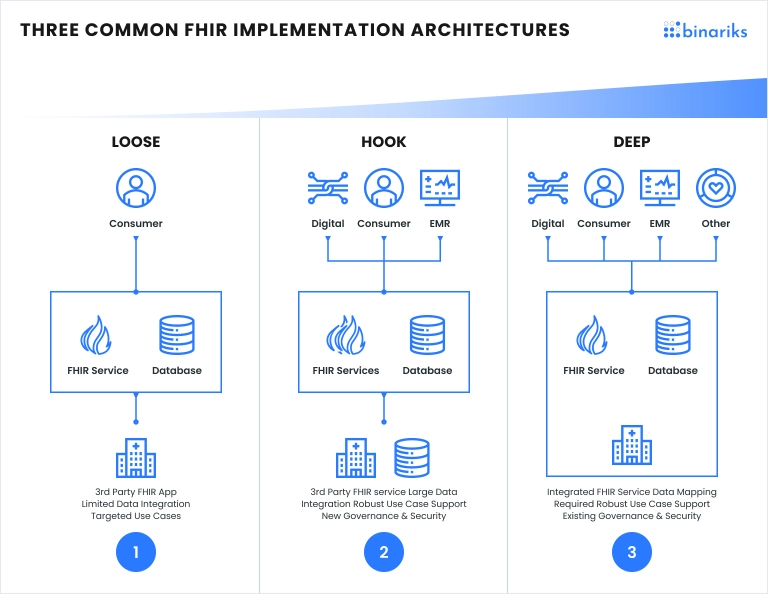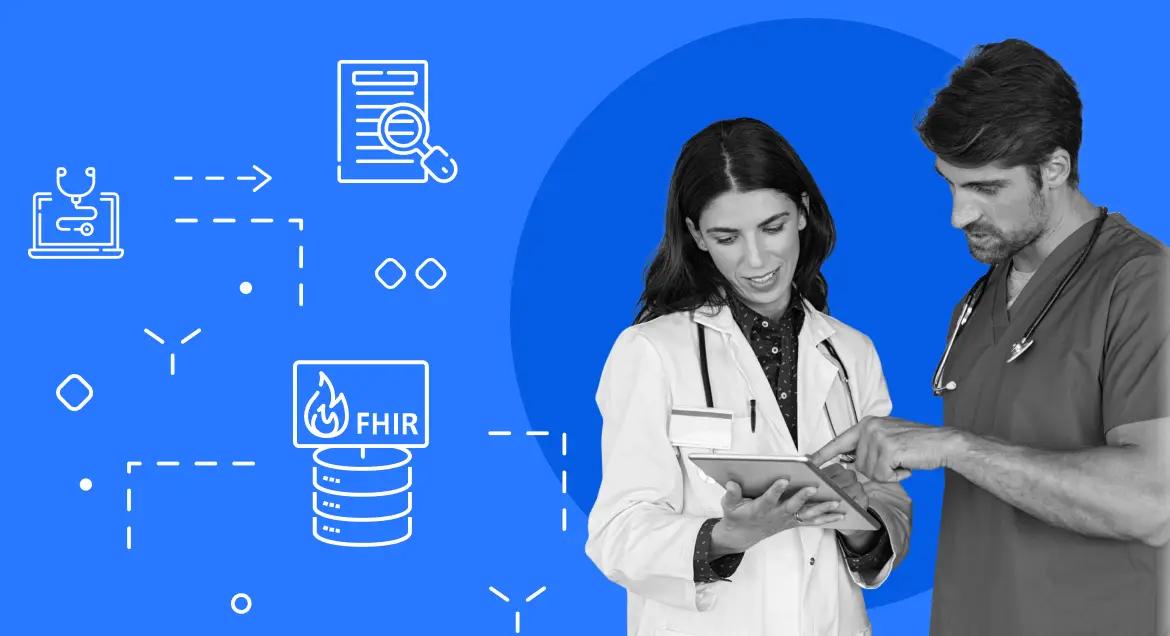If you want your healthcare institution to be modern, effective, and competitive, the question is simple: Are you ready to tap into the astonishing benefits of FHIR?
If you're unfamiliar with Fast Healthcare Interoperability Resources, it's time to get acquainted. It's not just an acronym; it's the warp drive of healthcare innovation. We're about to embark on a journey that will show you just how FHIR is turning the healthcare industry upside down and inside out, all for the better.

In this article, we'll dissect the five key benefits of FHIR, explore the challenges it faces, dive into real-life implementations, share our experiences, and leave you with interesting and useful insights.
Let's start.
5 key benefits of FHIR in healthcare
1. Enhanced data interoperability
One of the standout advantages of FHIR is its capacity to streamline data interoperability within healthcare organizations.
By adopting FHIR standards, healthcare providers and institutions can bid farewell to the era of data silos. This open and standardized framework facilitates the smooth exchange of patient records, lab results, and other vital data, allowing different systems to speak the same language.
For healthcare organizations, this translates to increased operational efficiency, reduced errors, and improved decision-making. For patients, it means quicker access to their health information and more informed care. Developers, too, find it easier to create and integrate healthcare applications, catalyzing innovation in the field.
2. Rapid implementation and scalability
One of the benefits of FHIR is that it brings these attributes to the forefront. Agility and scalability have long been elusive goals for healthcare. However, FHIR integration catapults healthcare organizations into a new era. FHIR's resource-oriented approach allows institutions to adapt swiftly to changing requirements.
Implementing FHIR-based solutions streamlines processes, leading to time and resource savings. This significantly benefits healthcare organizations by reducing costs and improving their ability to respond to emerging challenges.
3. Improved patient care and engagement
The FHIR advantages extend beyond mere administrative conveniences, touching the core of patient care and engagement. FHIR equips healthcare providers with the tools to make more informed decisions, thereby improving patient outcomes.
Furthermore, FHIR facilitates seamless access to health data, empowering patients to actively engage in their own healthcare journey. This heightened patient engagement translates into healthier lifestyles and better adherence to treatment plans.
4. Security and privacy reinforcement
In an era characterized by data security and privacy concerns, FHIR steps up with robust security features. It provides healthcare organizations with standardized authentication and authorization mechanisms, offering peace of mind that patient data is safeguarded. Not only does this reassure healthcare organizations, but it also instills confidence in patients that their sensitive information is well-protected.
5. Cost efficiency and future-proofing
Among the FHIR pros and cons, cost efficiency and future-proofing stand out prominently. Healthcare organizations are often caught in a conundrum of budget constraints and the ever-pressing need to stay technologically relevant. FHIR comes to the rescue by enabling cost-effective development and future scalability.
As the healthcare landscape evolves, FHIR keeps organizations at the forefront of technology without exorbitant costs. Patients benefit from a cost-effective and dynamic healthcare system that adapts to their evolving needs.
In a nutshell, the benefits of using FHIR are a game-changer for healthcare organizations and patients alike. FHIR turbocharges data interoperability, streamlines implementation, and enhances patient care. It strengthens security, safeguards privacy, and promotes cost-efficiency. It's not just a tech buzzword; it's a catalyst for a better, more patient-centered healthcare experience.
How to become FHIR-compliant
A detailed approach to FHIR implementation

Challenges and cons of FHIR
Amidst the explanation of FHIR benefits and advantages, it's crucial to address the flip side of the coin – the challenges and cons. FHIR, like any technology, isn't without its hurdles. One of the primary concerns is data security. While FHIR offers robust security features, the burden is on healthcare organizations to implement these features effectively. Without a well-thought-out security strategy, patient data could be at risk.
Another challenge lies in interoperability with existing legacy systems. Healthcare organizations often have older systems in place, and integrating FHIR with these can be a complex process.
Compatibility issues and data migration can slow down the transition to FHIR. Additionally, standardization across the healthcare industry is a work in progress. Variations in how different organizations implement FHIR can lead to inconsistencies in data exchange, potentially compromising its effectiveness.
Finally, cost can be a hurdle. While FHIR promises long-term cost efficiency, the initial investment in adopting and implementing FHIR can be substantial. Smaller healthcare organizations might find this financial burden challenging. So, while the advantages of using FHIR are clear, it's essential to navigate these challenges to harness its full potential.
As you can see, the path to reaping the full spectrum of fast healthcare interoperability resources benefits isn't without its obstacles. The hurdles are real, yet, understanding these challenges is the first step toward surmounting them and harnessing the incredible potential that FHIR offers to modern healthcare.
Real-life implementation and uses of FHIR
Before we start this block, let's clarify some important details. In different articles and posts about FHIR benefits you can find phrases like "Smart on FHIR " and "HL7 FHIR ".
- HL7 (Health Level Seven International) is a nonprofit organization that develops and maintains standards for exchanging healthcare information. Aiming to improve the accessibility, speed, safety, and quality of electronic health information exchange, HL7 tackles challenges such as defining the structure and content of messages shared between different healthcare systems and applications. When combined with FHIR, HL7 standards provide a consistent framework for data exchange in healthcare.
- SMART (Substitutable Medical Applications, Reusable Technologies) is a healthcare technology platform that enables the development of secure, interoperable healthcare applications, often referred to as SMART apps.
The advantages of using the FHIR HL7 data format are that apps can seamlessly integrate with electronic health records (EHR) and health IT systems, providing clinicians and patients with additional tools to enhance healthcare delivery.
With this being said, let's bite into some interesting real-life use cases of FHIR .
CoxHealth
CoxHealth, a Missouri-based health system, faced a shortage of dermatologists, leading primary care physicians (PCPs) to step in for dermatology exams. However, lacking specialized expertise in dermatology, PCPs turned to an FHIR-powered app, VisualDx, to enhance their diagnostic accuracy. VisualDx, a SMART on FHIR application, empowers doctors with medical imaging, visualization, and machine learning.
This tool enables them to compare various skin, hair, and nail conditions, resulting in more precise diagnoses. Integrated into CoxHealth's Cerner EHR, VisualDx saves physicians time by providing essential patient information, such as age, gender, medications, and existing conditions.
Accessible on mobile devices, VisualDx connects physicians to patient data both in and out of the office, facilitating comprehensive differential diagnoses and detailed condition information.
The United Kingdom’s National Health Service (NHS)
The United Kingdom’s National Health Service (NHS) stands at the forefront of digital healthcare transformation, adopting Fast Healthcare Interoperability Resources (FHIR) as a pivotal standard for its digital services. FHIR ensures seamless interoperability between diverse healthcare systems within the NHS infrastructure, allowing critical patient data to flow harmoniously across platforms, and optimizing healthcare delivery and decision-making.
This adoption has also led to the development of innovative services and applications, addressing a wide spectrum of healthcare needs, from improving patient care and monitoring to enhancing overall operational efficiency. With FHIR benefits as its cornerstone, the NHS drives the UK healthcare landscape towards increased connectivity, efficiency, and patient-centric care, benefitting both providers and individuals across the nation.
Improved interoperability for a healthcare referral platform
Revamping solution architecture and enabling interoperability with FHIR
Our experience
Binariks has a strong track record in implementing FHIR, and our portfolio includes notable use cases of FHIR in action. In particular, we have already worked on a solution for a non-emergency medical transportation company, an innovative patient health monitoring application provider, and a healthcare referral platform.

Leveraging our expertise in Fast Healthcare Interoperability Resources, we specialize in developing innovative strategies that drive healthcare transformation. When you choose Binariks, you gain access to a team of healthcare technology experts who possess not only FHIR knowledge but also a profound understanding of the healthcare ecosystem.
Final thoughts
As we wrap up this exciting journey through the FHIR landscape, we're thrilled to be your guides on this transformative path. FHIR is more than a buzzword, it's a game-changer, making healthcare smarter, more connected, and patient-centric. It is the bridge that connects healthcare organizations, providers, and patients. It's the universal language for health data, empowering you to take control of your health and well-being like never before.
So, as we part ways for now, remember that the FHIR revolution is here, and the future of healthcare is brighter than ever. Binariks can always be your dedicated partner in this journey. With our expertise and commitment to FHIR, we're rewriting the rules of healthcare, bringing innovation to the forefront.
FAQ
Share

